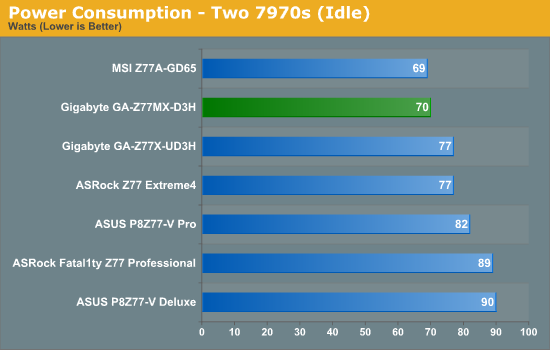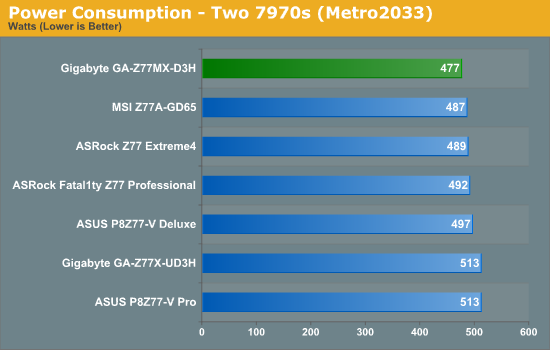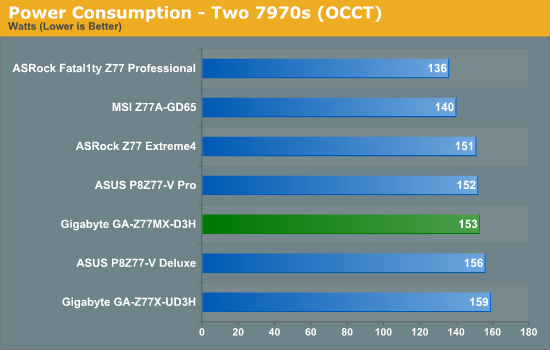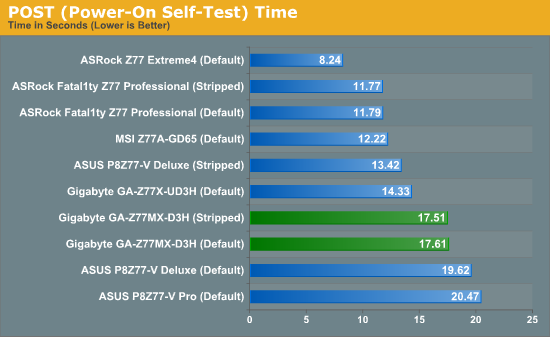Gigabyte GA-Z77MX-D3H Review – Z77 and MicroATX
by Ian Cutress on May 24, 2012 3:00 PM EST- Posted in
- Motherboards
- Gigabyte
- Z77
Test Setup
| Processor |
Intel Core i7-3770K ES (Stepping 9, Retail) 4 Cores, 8 Threads, 3.5 GHz (3.9 GHz Turbo) |
| Motherboards |
ASRock Z77 Extreme4 ASUS P8Z77-V Pro Gigabyte GA-Z77X-UD3H MSI Z77A-GD65 ASUS P8Z77-V Deluxe ASRock Fatal1ty Z77 Professional Gigabyte GA-Z77MX-UD3H |
| Cooling | Intel All-in-One Liquid Cooler |
| Power Supply | OCZ 1250W Gold ZX Series |
| Memory |
GSkill RipjawsZ 4x4 GB DDR3-2400 9-11-11 Kit GSkill TridentX 2x4 GB DDR3-2666 11-13-13 Kit |
| Memory Settings | XMP (2400 9-11-11) |
| Video Cards |
ASUS HD7970 3GB ECS GTX 580 1536MB |
| Video Drivers |
Catalyst 12.3 NVIDIA Drivers 296.10 WHQL |
| Hard Drive | Micron RealSSD C300 256GB |
| Optical Drive | LG GH22NS50 |
| Case | Open Test Bed - CoolerMaster Lab V1.0 |
| Operating System | Windows 7 64-bit |
| SATA Testing | Micron RealSSD C300 256GB |
| USB 2/3 Testing | OCZ Vertex 3 240GB with SATA->USB Adaptor |
Power Consumption
Power consumption was tested on the system as a whole with a wall meter connected to the OCZ 1250W power supply, while in a dual 7970 GPU configuration. This power supply is Gold rated, and as I am in the UK on a 230-240 V supply, leads to ~75% efficiency > 50W, and 90%+ efficiency at 250W, which is suitable for both idle and multi-GPU loading. This method of power reading allows us to compare the power management of the UEFI and the board to supply components with power under load, and includes typical PSU losses due to efficiency. These are the real world values that consumers may expect from a typical system (minus the monitor) using this motherboard.




Due to the size of the board and the lack of phase loading in any serious manner, the Gigabyte Z77MX-D3H does rather well in power usage especially at idle. During video, the board is somewhat thwarted with it's bigger brother needing less power.
POST Time
Different motherboards have different POST sequences before an operating system is initialized. A lot of this is dependent on the board itself, and POST boot time is determined by the controllers on board (and the sequence of how those extras are organized). As part of our testing, we are now going to look at the POST Boot Time - this is the time from pressing the ON button on the computer to when Windows starts loading. (We discount Windows loading as it is highly variable given Windows specific features.) These results are subject to human error, so please allow +/- 1 second in these results.

The controllers on board the Z77MX-D3H do not add much for POST times, and overall the Gigabyte is rather slow compared to its competitors. The ASRock Z77 Extreme4 for example is in a similar price bracket but takes around half the time to POST.
Overclocks
Here at AnandTech we want to provide quick and easy ways to determine if a board is good for you (with in-depth analysis of course). So here is a quick round up of our overclocking results. Overclocks are tested for stability with PovRay and OCCT - while these may not be the most strenuous of stability tests, it does offer a quick check for memory errors under high load (and also balances testing time with getting the next board on for review!).
|
CPU Speed (MHz) |
Voltage (Volts) |
PovRay Peak Temp (ºC) |
OCCT Peak Temp (ºC) |
Notes | |
|
ASRock Fatal1ty Z77 Professional |
4700 | 1.200 | 89 | 89 | PLL Overvoltage enabled |
|
ASRock Z77 Extreme4 |
4700 | 1.175 | 86 | 86 | LLC Level 1 |
|
ASUS P8Z77-V Deluxe |
4700 | 1.225 | 89 | 84 | PLL Overvoltage enabled |
|
ASUS P8Z77-V Pro |
4700 | 1.200 | 83 | 86 | PLL Overvoltage enabled |
|
Gigabyte Z77X-UD3H |
4700 | 1.200 | 82 | 86 | LLC Extreme |
|
Gigabyte Z77MX-D3H |
4700 | 1.200 | 80 | 84 | LLC Extreme |
|
MSI Z77A-GD65 |
4700 | 1.250 | 90 | - | PLL Overvoltage enabled |










25 Comments
View All Comments
Denithor - Thursday, May 24, 2012 - link
First page, below the first picture:This sentence makes no sense at all. You're missing a word or two or something.
Fourth page:
http://www.its-not-its.info/
And there's something else wrong with how that sentence reads, just not smooth at all.
Kharadmon - Friday, May 25, 2012 - link
It also appears to be missing a SATA-II port.
FozzyofAus - Thursday, May 24, 2012 - link
I realize it's in a different price category but any chance of a review of the Asrock uATX board?repoman27 - Thursday, May 24, 2012 - link
"The F10 BIOS supposedly updates the board to accept Xeon E5-12xx processors"I think the LGA 1155 Xeons are actually E3's, not E5's.
spikebike - Thursday, May 24, 2012 - link
I checked the Gigabyte site and no mention of the Xeon E3.
Can anyone confirm that if I buy one of these from Amazon and/or Newegg that I'll get a BIOS that will work with a Xeon E3-1230v2 or similar IVY bridge Xeon?
I don't want to end up with a motherboard that is unbootable until I find another older lga1155 CPU to get it going.
spikebike - Thursday, May 24, 2012 - link
Note the CPU compatibility list does list numerous E3 Xeons, but all of the Sandy Bridge variety. No Ivy Bridge Xeons (version 2) are listed.
tuxRoller - Friday, May 25, 2012 - link
Are those even available yet?spikebike - Friday, May 25, 2012 - link
Ya, newegg, amazon, provantage, ark.intel.com, etc.jtd871 - Friday, May 25, 2012 - link
Anandtech / Ian:Thanks for the great reviews of Z77 boards. Looking forward to seeing more of them.
+1 for including non-full-ATX form factors, as some tech sites don't even plan on covering them. I hope that there are some more uATX and mITX Z77 board reviews scheduled.
Lazlo Panaflex - Friday, May 25, 2012 - link
"I perhaps cannot see what the real voltage being applied to the CPU is unless I break out a DVM. It is also slightly devious to users who use the voltage value as a marker in reducing power usage. I hope that this will be changed in a future BIOS, but whether this change was malicious or not, it does raise questions as to what else Gigabyte may be changing from real values on the board to reported values."This is troubling. Ian - have you experienced this phenomenon on Gigabyte Z68 boards?